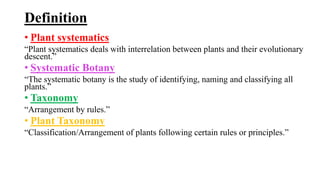Introduction to plant Systematics by sarah Ashfaq.pptx
- 1. Introduction to plant systematics Sarah Ashfaq
- 2. Introduction • Early botanists such as Theophrastus, Pedanius Dioscorides, and Pliny started the science of plant systematics, as each of them classified many plant species in their books. • Charles Darwin was the main influence on the science, with the publication of The Origin Of Species. He may have been the first to use phylogeny, and called the rapid development of all the higher plants within recent geological time "an abominable mystery".
- 3. Theophrastus Pedanius Dioscorides Pliny Charles Darwin
- 4. Definition • Plant systematics “Plant systematics deals with interrelation between plants and their evolutionary descent.” • Systematic Botany “The systematic botany is the study of identifying, naming and classifying all plants.” • Taxonomy “Arrangement by rules.” • Plant Taxonomy “Classification/Arrangement of plants following certain rules or principles.”
- 5. Classification • “It is the arrangement of plants into groups having common characteristics.” • Characteristics such as their reproductive structures, physical features, and evolutionary history. Figure: Plants classification Source: https://www.quora.com/What-is-the-classification- of-plants-and-their-types
- 6. Figure: Plant kingdom classification chart with examples Source: https://www.pinterest.com/pin/669136457110045537/
- 8. Identification • It is recognition of certain characters of flowers, fruits, leaf or stem and the application of a name of plant with those particular characteristics. How to Identify a Plant •Note the climate and region. •Observe stems and branches. •Note the leaf shape and size. •Check the leaf arrangement. •Note fruits and flowers. •Look for barbs, hairs, or thorns. •Note the smell. •Check the roots.
- 9. Figure: Identification of leaves Figure: Identification of flowers
- 10. Figure: Identification of fruits Figure: Identification of stem and root types
- 11. Nomenclature • Botanical nomenclature is the formal, scientific naming of plants. • It is related to, but distinct from taxonomy. • Plant taxonomy is concerned with grouping and classifying plants.
- 12. “International Code of Botanical Nomenclature” • The code is based on a two-name (binomial) system developed by the famous botanist Linnaeus. • Each plant is given a first name and last name, generally based in Latin, that is unique to each species.
- 14. References • Simpson, M. G. (2019). Plant systematics. Academic press. • Darwin, C. (2016). On the origin of species, 1859. • Green, M. L. (1927). History of plant nomenclature. Bulletin of Miscellaneous Information (Royal Botanic Gardens, Kew), 403-415. • Elhariri, E., El-Bendary, N., & Hassanien, A. E. (2014, December). Plant classification system based on leaf features. In 2014 9th International Conference on Computer Engineering & Systems (ICCES) (pp. 271-276). IEEE. • Lee, S. H., Chan, C. S., Wilkin, P., & Remagnino, P. (2015, September). Deep-plant: Plant identification with convolutional neural networks. In 2015 IEEE international conference on image processing (ICIP) (pp. 452-456). IEEE.
- 15. Thankyou














